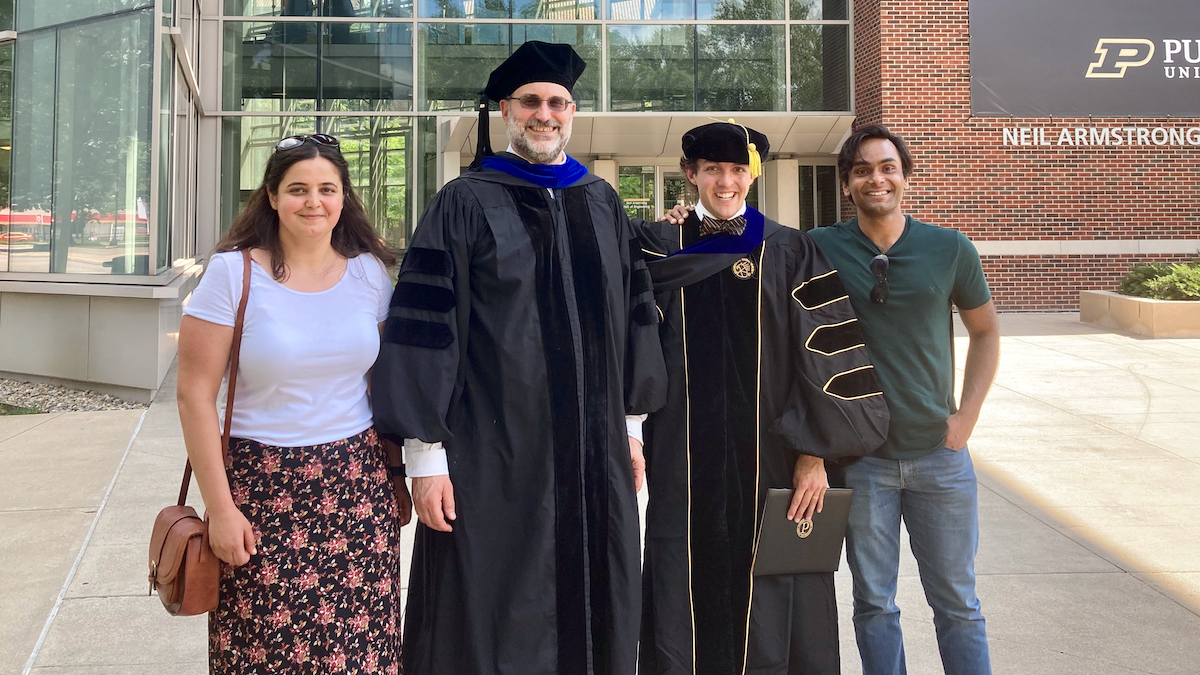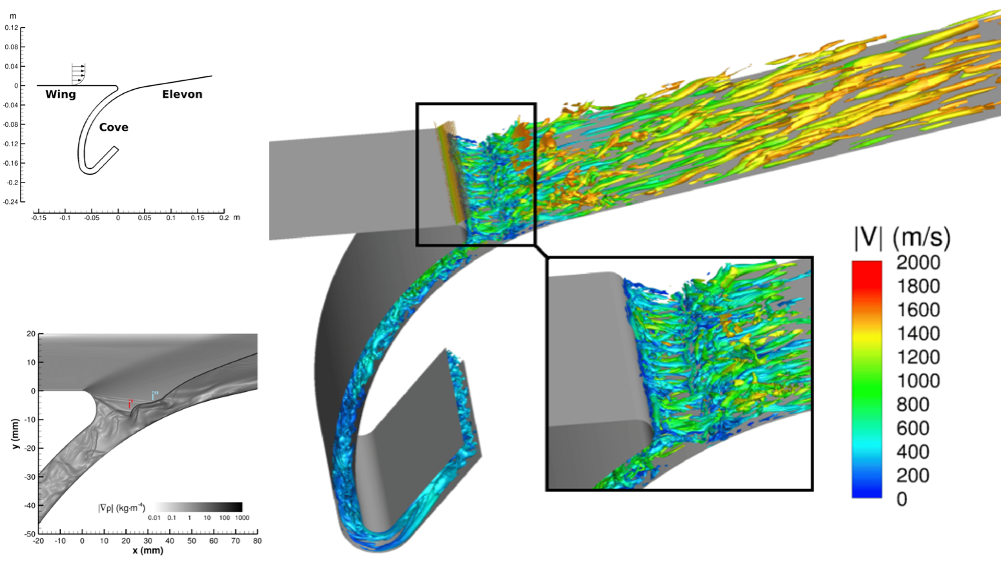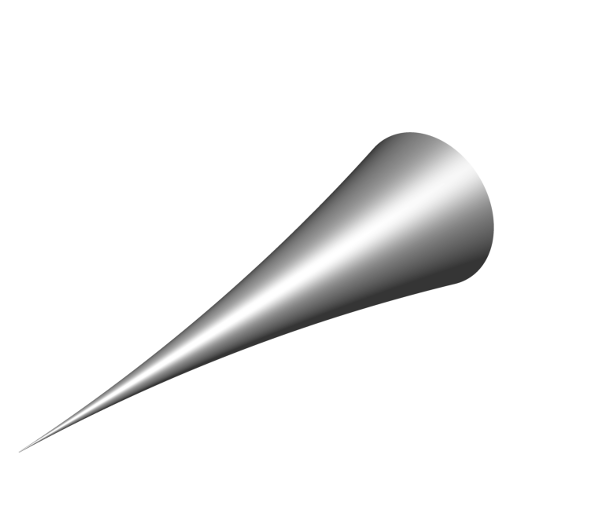Flow Resolution
News in 2021-2022 from Prof. Poggie's research group.
August 2022 Commencement
Congratulations to Dr. Geoffrey Andrews, my third PhD graduate at Purdue! Geoffrey took on the extremely challenging topic of computing the effect of wind tunnel noise on hypersonic laminar-turbulent transition, and is now headed off to a job at MIT Lincoln Laboratory in the Boston area.
Also visiting today were my previous PhDs Tugba Piskin (left, 2019) and Akshay Deshpande (right, 2021).
Workshop on Weakly Ionized Gases
Twenty-five years ago, Wright Laboratory (now part of the US Air Force Research Laboratory) hosted the first Workshop on Weakly Ionized Gases to promote collaboration with nations of the Former Soviet Union on research related to weakly ionized gases in aerospace applications. The late Lee Bain of the Wright Laboratory Propulsion Directorate (WL/PO) was the lead organizer, and talks covered diverse topics in plasma-based flow control, plasma-enhanced combustion, magnetohydrodynamic devices, and related areas.
The conference was very successful, and became an annual event, held in conjunction with AIAA conferences. Later workshops were organized by Julian Tishkoff of the Air Force Office of Scientific Research (AFOSR).
The WIG Workshops continued for many years, winding down as the politics changed. The legacy of the workshops continues through the AIAA Plasma Aerodynamics Discussion Group. See the discussion group's article in ONERA Aerospacelab Journal for a view of the field as of 2015. Vigorous international collaboration continues in the field, as evidenced by the diverse contributors to that review.
Hypersonic Gap Flows
An important element of hypersonic vehicle design is predicting the aerothermodynamic impact of geometric imperfections. Deviations from a smooth aerodynamic surface — roughness, steps, gaps, and cavities — are an inevitable part of the design compromise. Under programs sponsored by the Air Force Research Laboratory, our research group has recently examined the ability of standard engineering models to predict those flows, and has explored the interesting flow physics of these configurations.
One example of this class of flows is the gap that allows a missile's control fin to move. In a recent article in the AIAA Journal of Spacecraft and Rockets, we reported on simulations of a Mach 6 flow over a missile-fin-torque tube configuration that had been the subject of past experimental work. The results agreed fairly well with experiment, and uncovered high heating rates in regions that were inaccessible experimentally.
Another configuration that requires a gap to allow movement is the juncture of a wing and an elevon. That gap configuration (called a cove) was present on the Space Shuttle, and NASA carried out several experiments on heat transfer in the gap. We have performed detached eddy simulations (DES) of one of these experiments (at Mach 7) and have uncovered flow unsteadiness and an interaction between the gap flow and the reattaching shear layer. The details are reported in a recent AIAA Journal article.
Hypersonic Flight in the News
What is hypersonic?
Hypersonic missiles have figured heavily in the news over the last few years, and more so in recent weeks, but with the media reports has come a bit of confusion about hypersonic technology. One point worth discussing is the common definition of hypersonic flow as beginning at Mach 5. This is just a rule of thumb based on the upper limit of a regime in which traditional aerodynamic approximations apply. These approximations, and the resulting regime limits, are our problem, not nature's. There is no sudden change in flow features between Mach 4.9 and Mach 5.1. Formal mathematical definitions of hypersonic have been developed, but from a practical vehicle design perspective, a more useful definition of hypersonic is the regime in which aerodynamic heating becomes an overwhelming design concern.
Another point of confusion is the false impression that hypersonic missiles are new. In the mid-1940s, German V-2 rockets flew at the boundary of the hypersonic regime, and in 1949 a US test of the Bumper sounding rocket decisively demonstrated hypersonic flight. Reaching hypersonic speed is necessary to achieve orbit, so most space-related activity involves hypersonic flight. ICBMs are also hypersonic.
What hypersonic systems are new?
There are two military hypersonic missile concepts that are somewhat new. One is the boost-glide vehicle, in which an aerodynamic body with relatively high lift-to-drag ratio is boosted by a rocket to high altitude, and glides to its target. The military advantage is that a boost-glide vehicle’s maneuverability makes its path unpredictable to an adversary. The boost-glide concept builds on technology of the 1960s, such as the ASSET and PRIME programs, but with more ambitious maneuvering, as in the HTV-2 vehicle.
In addition to the obstacle of aerodynamic heating, flight control is a difficult challenge for boost-glide vehicles. There is little room for error, and the aerodynamic characteristics of the vehicle may change during its flight because of the harsh environment.
Another new hypersonic missile concept is the scramjet-powered cruise missile, such as the X-51 flight demonstrator. A scramjet burns fuel with air from the atmosphere, instead of oxidizer from a tank as in rocket propulsion. The flight path for this class of vehicle can be lower and flatter than that of a boost-glide vehicle, offering additional military advantages.
A hypersonic scramjet powered vehicle, however, has supersonic internal flow, and one of the main challenges for scramjet propulsion is maintaining combustion. Under supersonic conditions, ignition and mixing are extremely challenging, and the flow can easily transition to a less efficient ramjet mode of operation.
Are we behind? And if so, why?
In part, it is fair to say that we are behind. The United States does not have operational and reliable hypersonic missiles. On the other hand, US successes in space technology, such as the X-37, illustrate strong competence in the arena of hypersonic flight.
Investment in military hypersonic technology by the United States has come in waves, with impressive successes in flight test programs, followed by a failure to turn the results into operational systems. One reason for this is that development cost and unit cost for military hypersonic systems are very high. Military planners have to weigh the cost and benefit of hypersonic systems against other options for achieving their overall goals. As other aspects of military technology have evolved, however, hypersonic technology has looked more promising, offering the benefits of rapid strike and survivability in heavily defended airspace. This, and competition internationally, are the reasons for the recent sense of urgency about hypersonic missiles.
How can I learn about hypersonic technology?
Are you interested overcoming the challenges of hypersonic flight, for national defense or space access? Purdue offers many courses in this area, and a new Hypersonics Graduate Certificate is under development.
Military Simulations
Our team has been developing an alternative approach to modeling battles and civilian crises. In conventional wargames, units are described as discrete agents, essentially game pieces. In contrast, our approach is to treat units with a continuous flow, or probabilistic, model. This approach can potentially provide a more realistic portrayal of group motion, and describe the location of discrete objects in terms of a probability density.
We have written two articles describing the new model and its application:
- J. Poggie, S. Matei, and R. Kirchubel, "Simulating Military Conflict with a Continuous Flow Model," Journal of the Operational Research Society, Vol. 73, No. 2, pp. 273-284, 2022. DOI: 10.1080/01605682.2020.1825017
- J. Poggie, S. Matei, and R. Kirchubel, "Continuous Flow Model of a Historical Battle: A Fresh Look at Pickett's Charge," DOI: 10.48550/arXiv.2203.11035, 2022-03-21.
Some animations of the Gettysburg simulations, with details, are available here.
Wall Roughness Effects
Much academic work on computational aerodynamics focuses on idealized configurations. This is usually unavoidable: geometry simplifications are necessary to keep computational cost manageable. Nonetheless, practical constraints on real aircraft lead to many geometric features that can be considered imperfections from an aerodynamic standpoint: gaps, steps, and surface roughness are good examples. Our research team has begun an effort to address these imperfections, and evaluate our ability to predict their impact on aircraft performance.
As part of his Master's Thesis with our team, Jonathan Gaskins carried out high-fidelity simulations of turbulent boundary layers over rough surfaces and perfectly flat surfaces, comparing the results. To compare to experiments carried out the the University of Tennessee Space Institute, he chose a Mach number of about 2.0 and momentum thickness Reynolds number (based on wall viscosity) of about 15000. These were large, expensive calculations, utilizing a mesh of about 1.4 billion cells for each case.
A movie from the baseline flat wall case is shown below. The orange contours represent skin friction magnitude on the flat wall. The greyscale contours represent density in a side plane and an end plane. At this relatively high Reynolds number (for a computation) we see the large separation of scales between the large-scale bulges in the outer part of the boundary layer and the footprints of the near-wall streaks at the wall.
For comparison, a rough-wall case is shown below. The corrugated pattern of the wavy surface of the wall is apparent. Close observation of the skin friction patterns shows a tendency of the streaks to wind their way through the valleys in the roughness pattern. In ongoing work, Gaskins continues to analyze this rich dataset, and is exploring a broader range of flow parameters.
Jonathan Gaskins was co-advised by Prof. Poggie and Prof. Blaisdell under the "Multidisciplinary Hypersonics Program," sponsored by the Air Force Research Laboratory and a DoD HPCMP Frontier Project.
Forced DNS of Flared Cone
This August, Purdue graduate student Andrew Shuck successfully defended his MS Thesis entitled "Study of Transition on a Flared Cone with Forced Direct Numerical Simulation." In his research, Shuck simulated the flared cone experiments carried out in the Purdue Mach 6 Quiet Tunnel (BAM6QT) by Chynoweth (2018). DNS of this flow had previously been carried out by Hader (2019), but Shuck's work introduced a different numerical technique and forcing with fairly realistic wind tunnel noise. The flared cone configuration is shown below.
The video below illustrates how Shuck's approach captures transition for a strong forcing case. The orange contours show skin friction on the cone surface, and the grayscale contours show density in a side plane and end plane. The evolution of second-mode generated roped waves is apparent, as is three-dimensional wave interaction and breakdown into turbulence.
Andrew Shuck was co-advised by Prof. Poggie and Prof. Blaisdell under the "Multidisciplinary Hypersonics Program," sponsored by the Air Force Research Laboratory and a DoD HPCMP Frontier Project.
Panel on Defense Research
On March 11, 2021, the Purdue College of Engineering hosted Dr. Mark Lewis under the Distinguished Engineering Lecture series. A faculty panel discussion followed the virtual lecture, focusing on defense-related research at universities. A recording of the discussion is linked below. The panelists included Mark Lewis, Jonathan Poggie, Carol Handwerker, Jen Neville, and Steve Heister. Purdue Ph.D. student Liz Benitez was moderator.
You can find the link to Dr. Lewis's full lecture on the YouTube page.
Flows and Colors
The 1974 film "Courants et Couleurs" (Flows and Colors) highlights flow visualization experiments carried out in the water tunnel at Châtillon by the French aerospace research agency ONERA. As noted in the French language description on the original website, this film has both an artistic and scientific character.
You will probably recognize the very well-known delta-wing visualizations and the experiments on a model of the Concorde. Much of this work was led by Henri Werlé; see the summary in an Annual Review of Fluid Mechanics article by J. M. Délery.






